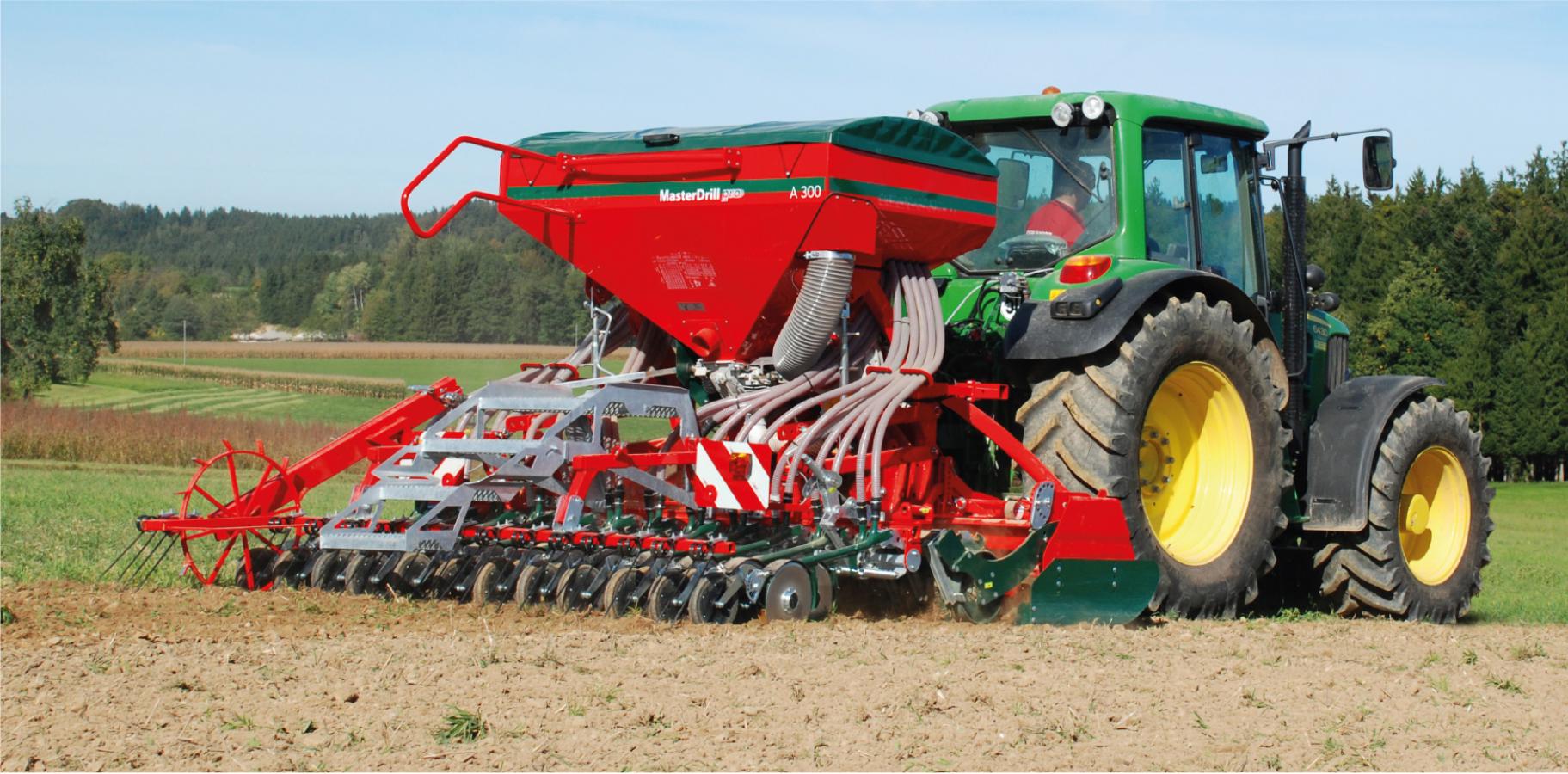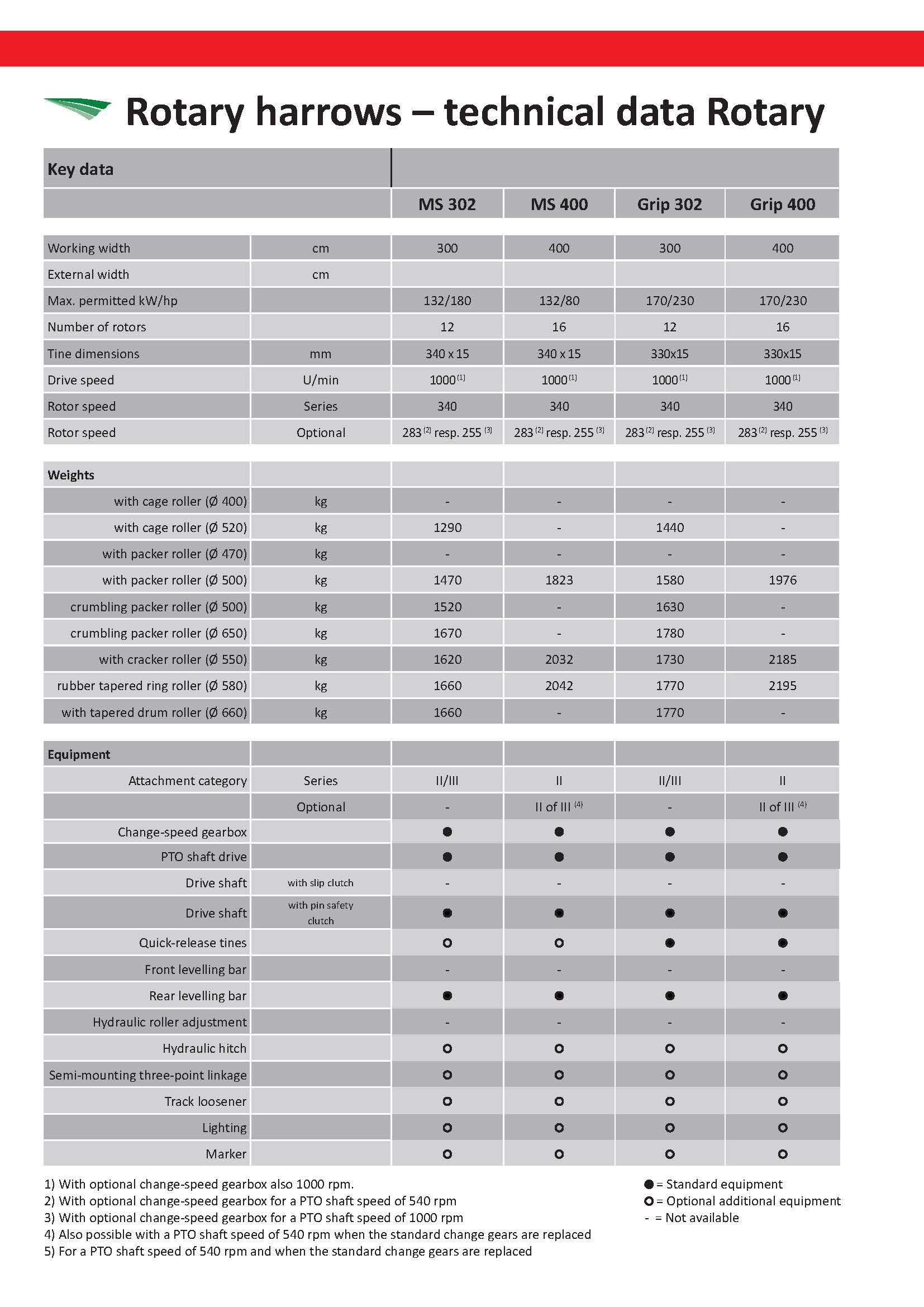The rotary cultivator with a bite!
The Arterra Grip rotary cultivator never fails to impress thanks to its unrivalled robustness and versatility. The position of the "at the ready" tines opens up new fields of application for the rotary cultivator. In addition to seedbed preparation on ploughed land, which the rotary cultivator naturally masters equally well, the emphasis in the rotary cultivator's work lies in universal applications in the field of mulch-sowing. The Arterra Grip produces outstanding work, both on pre-cultivated soils (e.g. after the cultivator) and in uncultivated conditions.
Advantages Arterra Grip:
- High quality Beyne change-speed-gearbox with PTO shaft drive as standard
- Twin gearbox pan with maximum stability and the largest pass
- Maintenance-free taper roller bearing
- Circular rotors with a tine quick changeover system as standard
- Smooth operation, no vibrations as tine brackets are not 90° offset
- Optimum seedbed preparation even in heavy mulching conditions
- Pivoting side impact plate designed to be extra long for optimum connection
Technology for professionals
Our machines stand out thanks to their robust and long living construction, their practical functionality and their ability to consistently meet future requirements thanks to innovative developments. We see ourselves as a partner to our customers, ready to provide comprehensive advice- and service concept. Agricultural technology from Beyne directly contributes to our customers' personal success and professional enjoyment.
Rotary harrows for all cultivation processes
Seedbed preparation - an important success factor:
A homogenous seedbed is the crucial basic requirement for the uniform germination and early development of the whole crop. This is because in comparison to the natural factors in place such as the type of soil, light conditions and water supply, growth and plant development are clearly influenced by seed preparation. Seedbed preparation - an important success factor: Arterra M 302 with crumbling packer roller.
The requirements for optimum seed preparation are:
• An even distribution of the plant remains (influences light conditions and nutrient reservoir)
• No deep tramlines or compressed zones in the soil
• Uniform working depth, prevention of unnecessarily deep cultivation
• Ground structuring with fine soil in the sowing horizon and a rougher, crumbly structure on the surface
Beyne rotary harrows are consistently geared towards these practical requirements. The wide selection of different designs covers the range between conventional seedbed preparation after ploughing right through to powerful, combined mulch-sowing. The various equipment options allow the best possible solutions and in doing so create the basis for a successful crop.
Fields of application
The use of rotary harrows can be essentially divided into three method groups which differ in the nature and sequence of work steps. The choice depends on the local conditions and the respective cultivation strategy.

- Conventional seedbed preparation in the ploughing process
Solo
Conventional soil cultivation is characterised by the clear sequence of the three cultivation processes - ploughing, seedbed preparation and sowing. Under good conditions, ploughing works all plant remains deep into the ground and weeds are destroyed through the deprivation of light and air. The cultivation depth is usually between 15 - 30 cm. An appropriate reconsolidation and sufficiently fine crumbling for optimum germination conditions is then achieved with secondary soil cultivation.
- Conventional seedbed preparation in the ploughing process
Combined with sowing technology
Due to its design principle, a rotary harrow is ideally suited for combined use with sowing technology. Thanks to the compact design, an enormously high lifting power of the tractor hydraulics is not required even with a seed drill, the rear axle and hydraulics are protected and the tractor and equipment remain safe to drive. Both mechanical or pneumatic drills as well as precision seed drills are suitable for the combination. The greatest advantages of combining the use of seedbed preparation and sowing are clearly that time and energy is saved but also, of course, from the point of view of the arable farmer, that the soil is protected due to a reduction of the individual passes.
- Conservation cultivation in the mulch-sowing process
Combined with sowing technology
Of course, rotary harrow/seeder combinations are also suitable for mulch-sowing because the intensive mixing of the mulch material and very good crumbling create optimum germination conditions. The heavier the soil conditions, the more obvious these advantages become, meaning that less passes with the cultivator are necessary. In addition, fewer demands are also placed on the coulter system of the seed drill. Behind the rotary harrow, conventional drills generally perform smoothly even in mulch-sowing. The rotary cultivator is particularly suited for work in mulching conditions. The "at the ready" tines provide very good penetration and even allow work to be carried out in soils which have not been pre-cultivated.
Change-speed gearbox
The gearbox is designed for very high tractor performances and stands out in the Arterra rotary harrow range due to the fact that it is extremely reliable. The PTO shaft stub is positioned centrally and right at the back. This ensures limited bending of the drive shaft and therefore smooth operation. Comes with PTO shaft drive as standard for combined use with seed drills. Can be used for a PTO shaft speed of both 540 and 1000 rpm. It is aligned simply by adjusting the change gears.
Rotors
With a 60 mm rotor shaft diameter, the Arterra Grip is equipped for even the most difficult applications. The rotor shaft and tine bracket are forged from one part and are therefore particularly robust. The design of the shaft seal is identical to that in the Arterra MS rotary harrow and guarantees long-term leak tightness and therefore the longevity of the Arterra
implements.
Tines
The "at the ready" tines provide the majority of the outstanding quality of work of the Arterra Grip. This arrangement ensures an optimum mixing effect with an optimum ground structuring for sowing: Spring-loaded parts are concentrated in the lower area of the processed layer, i.e. in the seed depositing area. There is also no subsoil compaction, the grip tines avoid lubricating horizons. The working characteristics of the grip tines also avoid a swath formation of harvest remains.
Pan design
With a material thickness of 8 mm, the "double- floor" construction is designed for the higher stresses during rotary cultivator operation. It also features enormous passes for this purpose. The tapered roller bearing is located in longer bearing tubes, which in turn means greater stability. The lower edges of the pan are also slanted. Thanks to these two design features, the Arterra Grip achieves incredibly large passes, in order to be able to work without blockages even in extreme mulching conditions.
Diamant tines
Strength meets strength with Beyne Diamant wearing parts
As a high-end solution for soils which increase wear/for work in hard soils or soils which have not been pre-cultivated, the Arterra MS knife tines and the grip tines of the Arterra Grip rotary cultivator are also available with a hard metal facing. Small hard metal plates are applied to the actual part in a unique production process. It is characterised by the high level of strength, even of the basic material. These diamant wearing parts therefore guarantee a significantly increased service life, reduced expenditure on replacing parts and an overall reduction in costs due to wear. Due to the dimensional stability of the tines, the working quality of the entire machine also remains consistently high throughout the entire lifecycle of the parts. This is particularly the case for the outstanding mixing effect of the grip tines.

Strenghts
Side plates
The stable side plates are double conducted, break-proof and light weight.

Depth adjustment
The placement of the depth adjustment at the Arterra machines takes place by a fine adjustment perforated plate with a coupling pin.

Levelling bar
Comfortable handling with the basic setting. Levelling bar rolled out – correction at working depth adjustment is not necessary, optimum crumbly structure, top quality levelling.

Accessories
Track eradicators
All Beyne rotary harrows are equipped with adjustable track eradicators. This option loosens the wheel tracks behind the tractor wheels and avoids irregular soil compaction.

Track indicator
The Arterra rotary harrows can also be fitted with track indicators for use with the seed drill. These are operated by a double-acting hydraulic system and fold vertically.

Rollers
Tubular cage roller:
400/480 or 520 mm diameter
- Good crumbling on average soils
- Leaves an open soil structure
- Lightweight

Packer roller:
470 or 500 mm diameter
- Very good all-round features
- Particularly clog-resistant, thanks to scraper
- Tough in stony conditions
- Good ground drive

Seed drill mounting
Hydraulic hitch: A hydraulically operated hitch is available for combination with 3-point mounted seed drills. Robustly built, the lifting geometry shifts the weight of the seed drill forward to the optimum position and therefore reduces the entire lifting force requirement of the tractor. High lifting power through 2 cylinders (optional with stroke limitation).
















